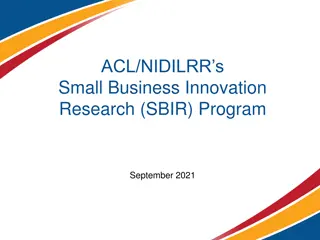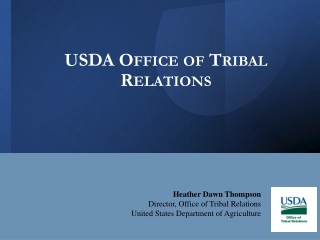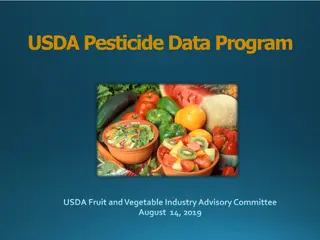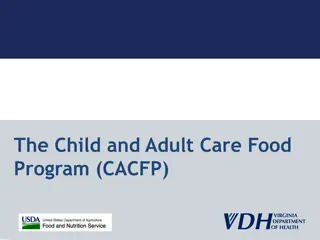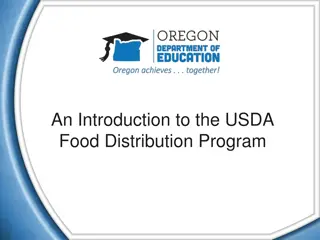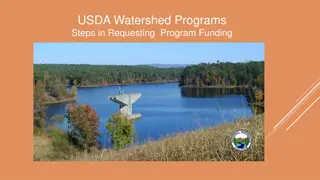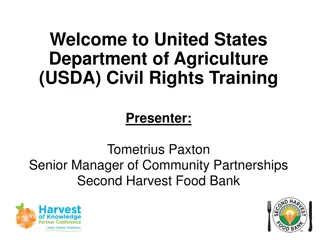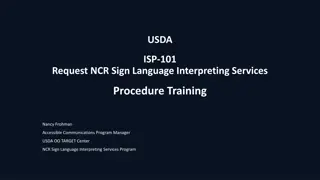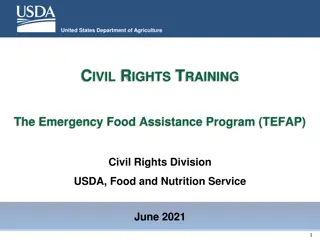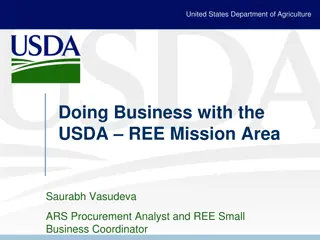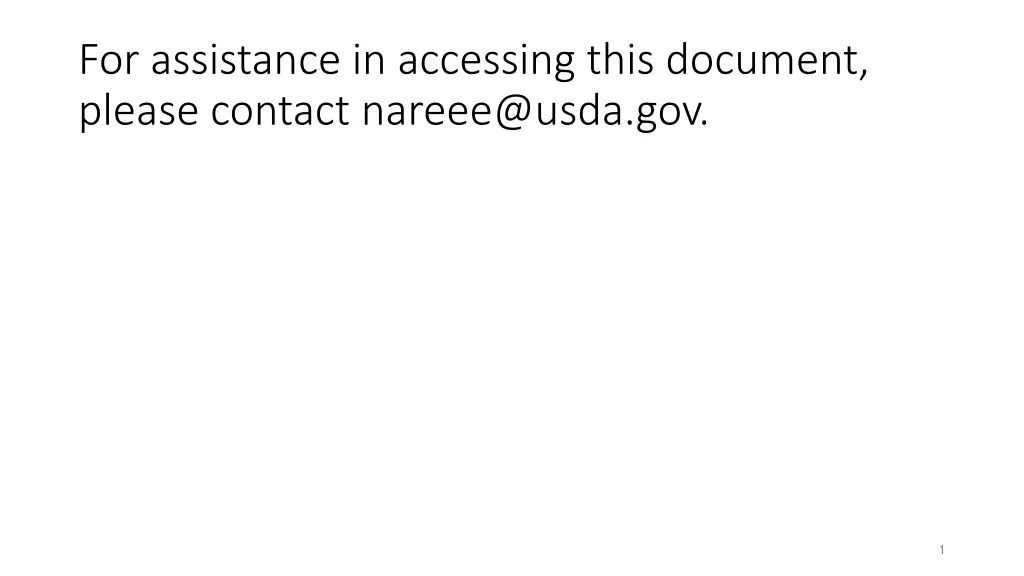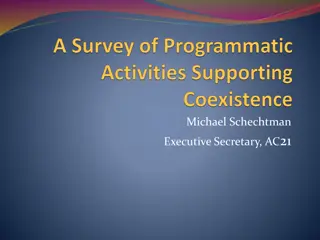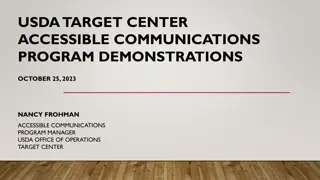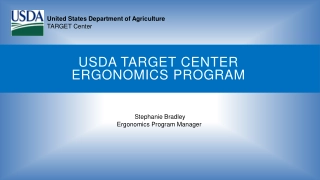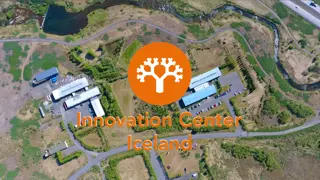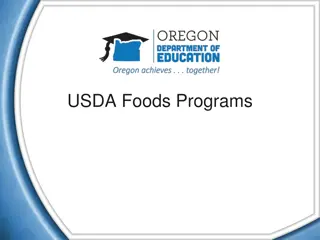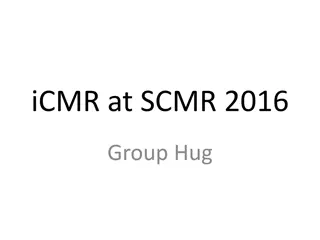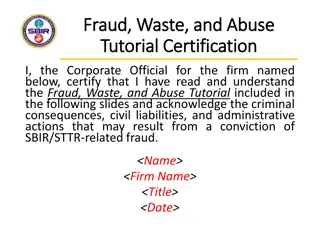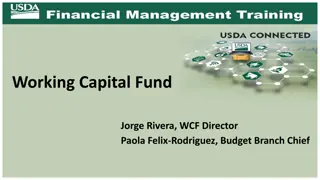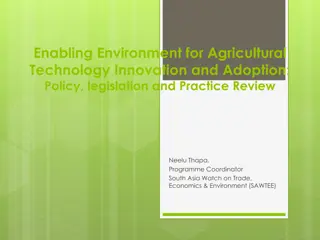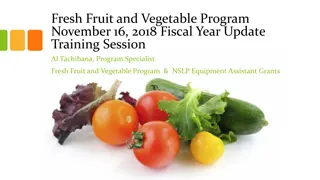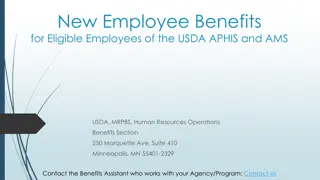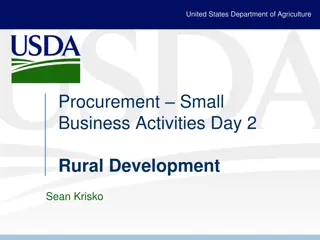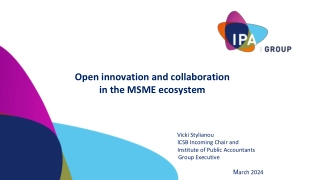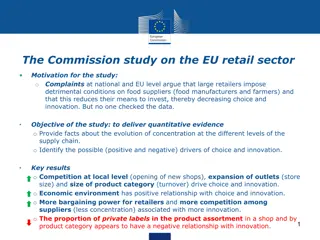USDA SBIR Program Overview for Innovation in Agriculture and Technology
The USDA SBIR program supports innovative projects in agriculture, the environment, and human health. It offers grants for ideas based on scientific merit and commercial potential. With Phase I and Phase II grants available, entrepreneurs can receive funding and commercialization assistance for their projects focusing on various technology areas like biotechnology, robotics, and food safety. The application process involves several steps, including electronic submission via Grants.gov.
Download Presentation

Please find below an Image/Link to download the presentation.
The content on the website is provided AS IS for your information and personal use only. It may not be sold, licensed, or shared on other websites without obtaining consent from the author. Download presentation by click this link. If you encounter any issues during the download, it is possible that the publisher has removed the file from their server.
E N D
Presentation Transcript
To Advance Knowledge For Agriculture, the Environment, Human Health and Well-being, and Communities National Institute of Food And Agriculture SBIR
Features of USDA SBIR Program Award Grants Only - Ideas are Investigator-Initiated Awards Based on Scientific and Technical Merit, PI and Company Qualifications, and Commercial Potential Proposals Reviewed by Confidential Peer Review Using Outside Experts From Non-profit Organizations Funds Allocated to Topic Areas in Proportion to Number of Proposals Received Subcontracting to Universities and USDA Labs Permitted and Encouraged SBIR
Features of USDA SBIR Program Phase I Grants = 8 Months/$100,000 Phase II Grants = 2 Years/$600,000 12 Month No-cost Extension Available Commercialization Assistance Programs for Both Phase I and Phase II Winners Contact with SBIR Program Available Anytime SBIR
Topic Areas Plant Production & Protection Biology Plant Production & Protection - Engineering Animal Production & Protection Aquaculture Food Science & Nutrition Biofuels and Biobased Products Air, Water and Soils Forests and Related Resources Rural and Community Development Small & Mid-Size Farms SBIR
Technology Areas Supported by the USDA/SBIR Program Information Technology Robotics Electronics Biotechnology Nanotechnology Microelectro Mechanical Systems (MEMS) Acoustics Remote Sensing Genetic Engineering Material/Coatings Food Safety Biofuels Machine Vision Precision Agriculture Engineering Physics Chemistry SBIR
Application Submission Application Submission Requires Many Steps to Complete the Process Download the USDA SBIR Solicitation at http://www.nifa.usda.gov/funding/sbir/sbir.html Electronic Submission is Mandatory via Grants.gov Obtain Data Universal Number System (DUNS) Number Register with System for Award Management (SAM) (replaced Central Contractor Registry (CCR) Register your Business with Grants.gov http://www.grants.gov/applicants/get_registered.jsp Register your company with the Small Business Administration (SBA) https://www.sbir.gov/registration SBIR
Solicitation/Proposal Schedule: Phase I FY 2018 Solicitation will be Released Late June/Early 2017 Phase I Proposal Deadline will be October 5, 2017 Panels will Meet in January & February of 2018 Award Decisions will be Made in Early March 2018 Phase I Grant Period will be from June 1, 2018 to January 31, 2019 Phase II FY 2017 Solicitation was released in late December of 2016 (only prior USDA Phase I winners are eligible) Phase II Proposal Deadline Date is be March 2, 2017 Phase II Grant Period will be from September 1, 2017 to August 31, 2019 SBIR
History of USDA SBIR Funding Year 2005 2006 2007 2008 2009 2010 2011 2012 2013 2014 2015 2016 Budget MM 19.20 19.17 18.20 18.30 19.71 22.26 19.20 19.30 18.41 21.61 22.09 24.52 Phase I 93/557 97/650 81/510 77/454 73/350 91/537 56/508 63/451 59/518 74/479 85/414 77/475 Phase II 40/79 32/61 39/71 38/69 33/53 39/62 37/72 25/50 28/52 24/47 28/51 34/66 SBIR
Geographical Distribution Of USDA SBIR Winners FY83- FY16 NE CA W NC S CA 430 CO WA HI OR ID MT AZ WY NM UT AK NV MH 155 150 109 105 64 56 52 51 40 28 18 11 1 MA NY PA MD NJ ME CT DE VT NH DC RI WV 170 130 101 81 65 57 51 32 26 19 7 7 6 MI WI OH IA KS MN IN MO IL SD NE ND 122 101 90 79 71 69 65 49 47 35 32 31 TX VA NC FL AR GA TN OK LA KY SC AL MS PR VI 118 95 90 73 46 43 41 34 33 25 24 20 20 2 1 430 12.4% 840 24.1% 752 21.6% 792 22.8% 665 19.1% SBIR
University and Government Scientist Involvement in USDA SBIR Program Strongly encouraged Scientists may serve as consultants or receive a subcontract (limited to no more than 1/3 of Phase I award or 1/2 of Phase II award) and continue to work full time at their home institution Scientists may serve as the principal investigator on an SBIR grant, by reducing employment at their home institution to 49% for the duration of the grant and if the SBIR research is performed someplace other than their research lab It is usually not acceptable for university or government scientists to serve as consultants and have all the research done in their lab SBIR
Advice for Phase I Provide a VISION of where you want to be at the end of Phase II Focus the Phase I research on critical enabling factor(s) Sell the importance of your project Provide a detailed experimental plan Provide insight into commercial potential Show connectivity with the communities you are intending to serve SBIR
Factors that Improve Chances for Commercial Success High Scientific/Technical Merit Good Consultants, CRADA Business Expertise Phase III Partners Marketing Plan Participate in the Phase I and Phase II Commercialization Assistance Programs SBIR
USDA SBIR HOMEPAGE www.nifa.usda.gov/fo/sbir Program Information Solicitation (Request for Applications) Technical Abstracts Link to SBA and Other SBIR Programs Upcoming SBIR Conferences Find the Expert (CRIS & ARS) PowerPoint Presentation Success Stories Impact Newsletter SBIR
U.S. Department of Agriculture Small Business Innovation Research Program Dr. Charles Cleland Biofuels and Biobased Products Dr. Charles Cleland Forests and Related Resources Dr. Jodi Williams Food Science and Nutrition Dr. Gene Kim Aquaculture Dr. Robert Nowierski Plant Production and Protection Biology Dr. Brent Elrod Rural and Community Development Dr. Robert Smith Animal Production and Protection Dr. Denis Ebodaghe Small and Mid-Size Farms Dr. Karelyn Cruz Air, Water and Soils Scott Dockum Program Coordinator, SBIR Dr. Rachel Melnick Plant Production and Protection - Engineering Elden Hawkes Program Specialist, SBIR SBIR
SUCCESS STORIES SBIR
Whole Trees, LLC Technology Developed Structural Testing of Branched Timber and Truss Assemblies Round timber can substitute for steel and concrete in medium and large scale construction under Type IV: "Heavy Timber Framing." SBIR History Phase I 2011 ($99K) Phase II 2012 ($362K) 8.1 Forests and Related Resources Commercialization Success The company will provide the ceiling joists of the 57,000-square-foot Festival Foods grocery store which will include ash trees being removed from the city of Madison due to emerald ash borer infestation. Raised $1.6M in private equity funding since the initial SBIR grant. SBIR
Harrisvaccines, Inc. Technology Developed Developed new custom, life-saving vaccines that responds to new diseases as they emerge for livestock. Developed a rapid 4-6 week production time for each new vaccine. Commercialization Success Just four months after the Porcine Epidemic Diarrhea (PED) virus broke out in the United States and affected 50% of the swine population, Harrisvaccines commercialized a vaccine that prevented this deadly disease. Went from selling 1 million doses of vaccines in 2012 to selling 5-7 million doses a year currently November 12, 2015, Merck Animal Health Acquired Harrisvaccines for a undisclosed amount. SBIR History Phase I in 2009 ($100K); Phase II in 2009($346K); 8.3 Animal Production and Protection SBIR
Nitrate Elimination Company, Inc. Technology Developed Developed nitrate test kits that allow farm managers to determine nitrate accumulation levels on the farm. This test kit will help agricultural producers manage nitrate concentrations, reduce costly nitrogen fertilizer applications, and protect the environment from pollution. SBIR History Phase I 2006 ($80K) Phase II 2007 ($364K) 8.4 Air, Water and Soils Commercialization Success In the final stages to receive EPA certification as a standard method for all nitrate testing under the Clean Water Act. Nitrate test kits are used as the standard method within all US Geological Survey (USGS) soil laboratories. SBIR
Altaeros Energies Technology Developed Altaeros Buoyant Airborne Turbine (BAT) leverages proven aerospace technology to lift a wind turbine into the strong, consistent winds beyond the reach of traditional towers. SBIR History Phase I 2011 ($100K) Phase II 2012 ($450K) 8.6 Rural Development Commercialization Success First commercial products to be sold in 2015. Technology was featured in CNN s 2014 edition of THE CNN 10: Inventions and in the New York Times. Telecoms group SoftBank has invested $7m in Altaeros Energies for future deployment of the BAT technology in Japan. SBIR
Freund`s Farm, Inc. Technology Developed What began on the farmhouse kitchen stove as an idea for a better biodegradable pot has grown into year round production of millions of CowPots to date. From a 3 inch pot for seed starting to a 17 inch pot for trees and shrubs, CowPots, LLC has expanded their innovative product line to match the diverse needs of the green industry. Commercialization Success Since being featured on Discovery Channel s Dirty Jobs with Mike Rowe in 2007, CowPots are now available internationally. Can be purchased from major worldwide sellers such as Amazon.com, cowpots.com and greenhousemegastore.com. SBIR History Phase I in 2006 ($54K); Phase II in 2007($317K); 8.11 Animal Waste Management (Topic Area Discontinued) SBIR
Eldertide, LLC. Technology Developed Began by looking at native species of elderberries to see which had the highest antioxidant profiles and could be successfully cultivated. Led to the development of a proprietary juice blend with benefits that include strong anti-viral properties, particularly against certain strains of the flu. SBIR History Phase I in 2009 ($80K); Phase II in 2010($400K); 8.12 Small and Mid-Size Farms Commercialization Success Product line, developed with the help of three SBIR awards, is available for purchase at Whole Foods stores nationwide. Nearly $700,000 with an additional $575,000 pending. Average annual growth of over 50%. SBIR
Trellis Growing Systems Technology Developed Developed trellis system for cultivation of blackberries in IN, OH and adjacent states Trellis system 1) protects plants against cold and desiccation in the winter, 2) protects fruit against sun scorch, and 3) reduces harvesting labor by 33% SBIR History Phase I 2008 ($74K) Phase II 2009 ($350K) 8.13 Plant Production & Protection - Engineering Commercialization Success Establishment of blackberry industry where it did not exist before Trellis system has been installed on more than 60 farms with over 300 acres in cultivation that generate sales of over $9 million/year SBIR
U.S. Department of Agriculture Small Business Innovation Research Program Elden Hawkes Waterfront Centre 800 9th Street, SW, Suite 3258 Washington, DC 20024 Phone: (202) 401-6516 Fax: (202) 401-6070 E-mail: ehawkes@nifa.usda.gov Web Site: www.nifa.usda.gov/fo/sbir SBIR
ANY QUESTIONS? SBIR



